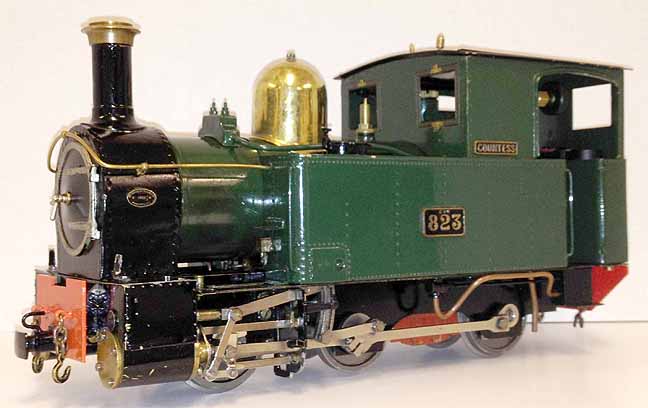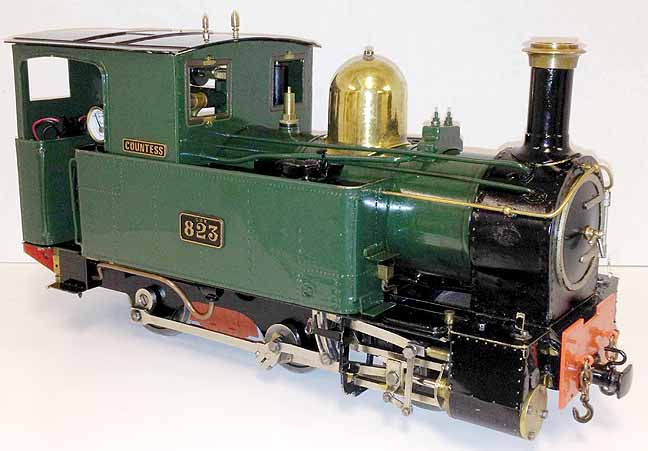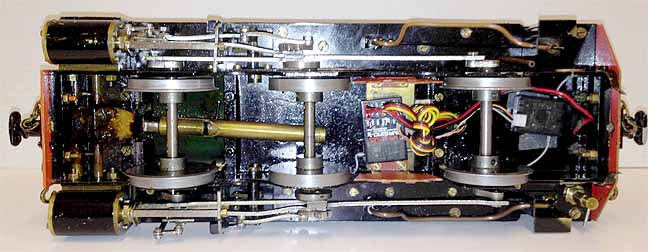Back to Sidestreet Bannerworks
Click here to find out how your engine can be featured!
.


Paul Hagglund's
Pearse Countess
by Paul Hagglund
Everett, Washington
Photos by the author
February, 2013
Pearse Locomotives was founded in 1993 by Ian Pearse and his father, Donald, in Church Stretton, Shropshire, England. The company built 707 locomotives until 2011 but production slowed after founding of Accucraft UK in 2004. In some respects, Pearse's products were refinements of the Merlin Locomotive Works products of years past. Piston valves were employed across the range of locomotives, using both piston reversers and abbreviated Walschaerts valve gear for reversing action. Countess employs the latter, which works well. One must be careful to keep fingers away from the vicinity of the return cranks when lifting, as they can sometimes be shifted and throw off the timing.
The model
The locomotive under examination is works No. 52, built in early 1994. Its bodywork is comprised of nice brass etchings that are festooned with rivet detail. Dummy lubricators adorn both tank fronts, and the signature Great Western lamp irons frame the substantial cast smokebox. The Countess' visual presence is augmented by its considerable weight, which gives smooth tracking and plenty of pulling power. According to paperwork that came with my loco, it was delivered to a customer in Michigan in April of 1994. It arrived in the greater Seattle area in 2001 from a well-known internet auction site, having resided in two collections before I acquired it in 2011.
Countess has been looked after over its lifetime but it has obviously done a fair bit of running. Coupling-rod-bearing holes are quite ovaled, with the main rods following the same road. I was fortunate to get my hands on a set of new coupling rods and cylinder seals from Simon Whenmouth at Anything Narrow Gauge. The piston rings and packing rings have been replaced but I have not yet stripped the loco down for the new coupling rods. I also lapped the whistle/regulator valve and replaced all the O-rings and gaskets therein to restore steam-tightness. The most recent modification was replacing the slow and distinctly glitch prone 27MHz radio set with a new 2.4GHz model, a most worthwhile improvement.
Pearse's locos all sported some handy features aimed at making the loco tidy and user friendly, and they display some interesting thinking and solutions. The lubricator drain and boiler overflow are handily piped away below the footplate to keep the cab floor from getting dirty quite so quickly. (Accucraft UK's locos are set up in the same manner, though they do not feature the nice needle valve on the boiler overflow that Pearse used.) The aforementioned whistle and throttle valve seems to draw inspiration from the combined throttle and lubricator used on some Merlin products. It is certainly an interesting way to add another feature while using only two servos. Countess is equipped with a second throttle on the steam turret that further regulates steam reaching the cylinders. This also helps prevent the loco from sucking oil out of the capacious lubricator and into the boiler. From what I've seen of Pearse locos in action, they consume large quantities of steam oil, even with restrictors fitted to the lubricator. The end result is a lovely plume of blue smoke as the oil burns away in the smokebox.
The run
My run was undertaken at a regular Puget Sound Garden Railway Society steamup hosted by Peter Comley. The loco was prepared in the usual way, making sure to use a mixed gas in observance of the 50-degree November day. I found last winter that Countess will run in the cold, but it takes a little more effort and coaxing.
Countess took about nine minutes to expel excess water and start showing pressure, but was ready to move scarcely three minutes later. I topped up the gas to get a decent run length, coupled on a train of six wagons and a brake van, and set off around Pete's mainline.
On two occasions, I had to reverse into a siding to allow faster trains to pass, but this was a doddle with the new radio set. The whole experience was further enhanced by the nice whistle fitted to the loco. Countess ambled nicely around Pete's large layout for about 35 minutes (four laps total), at which point I knew the loco would not make another full circuit. I therefore decided to shut it down. Quick calculations showed that I had averaged a little more than 15 scale miles per hour during the run.
Pearse's Countess is a nicely detailed and robustly built engine that is enjoyable to run. Despite some mechanical wear, it is still an excellent performer.
|
|
|
| Builder | Pearse Locomotives |
| Date completed | 1994 |
| Gauge | 1 (45mm) |
| Scale | 16mm = 1'0" |
| Boiler type | Single flue, gas fired |
| Fittings | Safety valve, pressure gauge, water-level tap, regulator |
| Blowoff pressure | 40 psi |
| Fuel | Butane |
| Cylinders | Two, double-acting piston valve |
| Reversing gear | Abbreviated Walschaerts |
| Lubricator | Displacement |
| Dimensions | Length, 11-3/8"; width, 4-1/4"; height, 6-1/8" |
| Weight | 10 pounds |

Below: The right side. Although the prototype has D-valves, the model employs piston valves.






Back to Sidestreet Bannerworks
Click here to find out how your engine can be featured!
This page and its contents
Copyright Sidestreet Bannerworks, 2013